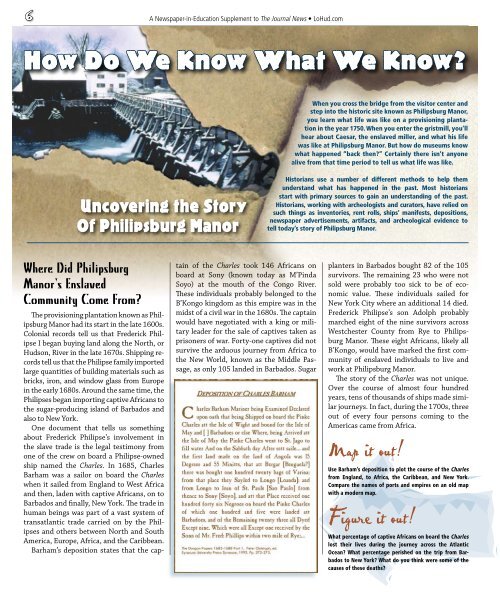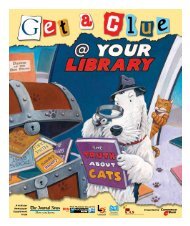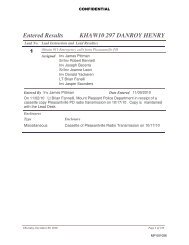Slavery in the Lower Hudson Valley - The Journal News
Slavery in the Lower Hudson Valley - The Journal News
Slavery in the Lower Hudson Valley - The Journal News
Create successful ePaper yourself
Turn your PDF publications into a flip-book with our unique Google optimized e-Paper software.
A <strong>News</strong>paper-<strong>in</strong>-Education Supplement to <strong>The</strong> <strong>Journal</strong> <strong>News</strong> • LoHud.com<br />
How Do We Know What We Know?<br />
When you cross <strong>the</strong> bridge from <strong>the</strong> visitor center and<br />
step <strong>in</strong>to <strong>the</strong> historic site known as Philipsburg Manor,<br />
you learn what life was like on a provision<strong>in</strong>g plantation<br />
<strong>in</strong> <strong>the</strong> year 1750. When you enter <strong>the</strong> gristmill, you’ll<br />
hear about Caesar, <strong>the</strong> enslaved miller, and what his life<br />
was like at Philipsburg Manor. But how do museums know<br />
what happened “back <strong>the</strong>n?” Certa<strong>in</strong>ly <strong>the</strong>re isn’t anyone<br />
alive from that time period to tell us what life was like.<br />
Uncover<strong>in</strong>g <strong>the</strong> Story<br />
Of Philipsburg Manor<br />
Historians use a number of different methods to help <strong>the</strong>m<br />
understand what has happened <strong>in</strong> <strong>the</strong> past. Most historians<br />
start with primary sources to ga<strong>in</strong> an understand<strong>in</strong>g of <strong>the</strong> past.<br />
Historians, work<strong>in</strong>g with archeologists and curators, have relied on<br />
such th<strong>in</strong>gs as <strong>in</strong>ventories, rent rolls, ships’ manifests, depositions,<br />
newspaper advertisements, artifacts, and archeological evidence to<br />
tell today’s story of Philipsburg Manor.<br />
Where Did Philipsburg<br />
Manor’s Enslaved<br />
Community Come From?<br />
<strong>The</strong> provision<strong>in</strong>g plantation known as Philipsburg<br />
Manor had its start <strong>in</strong> <strong>the</strong> late 1600s.<br />
Colonial records tell us that Frederick Philipse<br />
I began buy<strong>in</strong>g land along <strong>the</strong> North, or<br />
<strong>Hudson</strong>, River <strong>in</strong> <strong>the</strong> late 1670s. Shipp<strong>in</strong>g records<br />
tell us that <strong>the</strong> Philipse family imported<br />
large quantities of build<strong>in</strong>g materials such as<br />
bricks, iron, and w<strong>in</strong>dow glass from Europe<br />
<strong>in</strong> <strong>the</strong> early 1680s. Around <strong>the</strong> same time, <strong>the</strong><br />
Philipses began import<strong>in</strong>g captive Africans to<br />
<strong>the</strong> sugar-produc<strong>in</strong>g island of Barbados and<br />
also to New York.<br />
One document that tells us someth<strong>in</strong>g<br />
about Frederick Philipse’s <strong>in</strong>volvement <strong>in</strong><br />
<strong>the</strong> slave trade is <strong>the</strong> legal testimony from<br />
one of <strong>the</strong> crew on board a Philipse-owned<br />
ship named <strong>the</strong> Charles. In 1685, Charles<br />
Barham was a sailor on board <strong>the</strong> Charles<br />
when it sailed from England to West Africa<br />
and <strong>the</strong>n, laden with captive Africans, on to<br />
Barbados and f<strong>in</strong>ally, New York. <strong>The</strong> trade <strong>in</strong><br />
human be<strong>in</strong>gs was part of a vast system of<br />
transatlantic trade carried on by <strong>the</strong> Philipses<br />
and o<strong>the</strong>rs between North and South<br />
America, Europe, Africa, and <strong>the</strong> Caribbean.<br />
Barham’s deposition states that <strong>the</strong> capta<strong>in</strong><br />
of <strong>the</strong> Charles took 146 Africans on<br />
board at Sony (known today as M’P<strong>in</strong>da<br />
Soyo) at <strong>the</strong> mouth of <strong>the</strong> Congo River.<br />
<strong>The</strong>se <strong>in</strong>dividuals probably belonged to <strong>the</strong><br />
B’Kongo k<strong>in</strong>gdom as this empire was <strong>in</strong> <strong>the</strong><br />
midst of a civil war <strong>in</strong> <strong>the</strong> 1680s. <strong>The</strong> capta<strong>in</strong><br />
would have negotiated with a k<strong>in</strong>g or military<br />
leader for <strong>the</strong> sale of captives taken as<br />
prisoners of war. Forty-one captives did not<br />
survive <strong>the</strong> arduous journey from Africa to<br />
<strong>the</strong> New World, known as <strong>the</strong> Middle Passage,<br />
as only 105 landed <strong>in</strong> Barbados. Sugar<br />
planters <strong>in</strong> Barbados bought 82 of <strong>the</strong> 105<br />
survivors. <strong>The</strong> rema<strong>in</strong><strong>in</strong>g 23 who were not<br />
sold were probably too sick to be of economic<br />
value. <strong>The</strong>se <strong>in</strong>dividuals sailed for<br />
New York City where an additional 14 died.<br />
Frederick Philipse’s son Adolph probably<br />
marched eight of <strong>the</strong> n<strong>in</strong>e survivors across<br />
Westchester County from Rye to Philipsburg<br />
Manor. <strong>The</strong>se eight Africans, likely all<br />
B’Kongo, would have marked <strong>the</strong> first community<br />
of enslaved <strong>in</strong>dividuals to live and<br />
work at Philipsburg Manor.<br />
<strong>The</strong> story of <strong>the</strong> Charles was not unique.<br />
Over <strong>the</strong> course of almost four hundred<br />
years, tens of thousands of ships made similar<br />
journeys. In fact, dur<strong>in</strong>g <strong>the</strong> 1700s, three<br />
out of every four persons com<strong>in</strong>g to <strong>the</strong><br />
Americas came from Africa.<br />
Map it out!<br />
Use Barham’s deposition to plot <strong>the</strong> course of <strong>the</strong> Charles<br />
from England, to Africa, <strong>the</strong> Caribbean, and New York.<br />
Compare <strong>the</strong> names of ports and empires on an old map<br />
with a modern map.<br />
Figure it out!<br />
What percentage of captive Africans on board <strong>the</strong> Charles<br />
lost <strong>the</strong>ir lives dur<strong>in</strong>g <strong>the</strong> journey across <strong>the</strong> Atlantic<br />
Ocean? What percentage perished on <strong>the</strong> trip from Barbados<br />
to New York? What do you th<strong>in</strong>k were some of <strong>the</strong><br />
causes of <strong>the</strong>se deaths?






